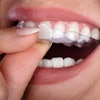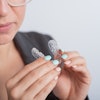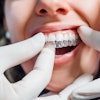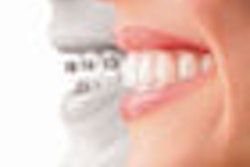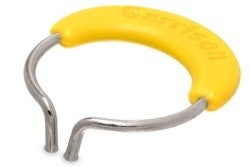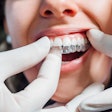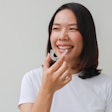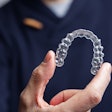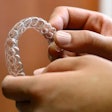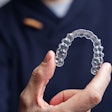
So you've taken a course on Invisalign and now you think you can straighten teeth. Maybe so. But watch out. These high-tech plastic aligners may not work as well as old-fashioned braces...in which case there could be a lawyer in your future.
That's the word from Daniel Kuncio, D.D.S., a New York orthodontist, and his colleagues at the Montefiore Medical Center in the Bronx. The team compared the teeth of 11 patients treated with Invisalign to 11 treated with conventional braces three years after the two groups had finished their treatments. They found that the Invisalign patients' teeth had relapsed significantly more than the patients using traditional braces.
"The take-home message is that you have to be very careful with this product," says Dr. Kuncio, whose study was published in the September issue of Angle Orthodontics. "It's easy to get into trouble." Kuncio should know. He was called as an expert witness in the malpractice trial of a general dentist accused of botching an orthodontic treatment with Invisalign. He warns that many such lawsuits could crop up soon as more and more general dentists begin using Invisalign.
"The take-home message: be very careful with this product"
Introduced in 1999, the system caught on fast, partly because it requires less expertise and less training than conventional braces, opening the world of orthodontics a bit to general dentists. Dentists simply make impressions of their patients' teeth, then send them to Invisalign's creator, Align Technology of Santa Clara, Calif. Technicians at the company use computer modeling to create a set of clear plastic aligners, each designed to move teeth a little bit farther in the desired direction.
Invisalign is popular among patients because the transparent, removable aligners are much less noticeable and more comfortable than conventional braces, says Robert L. Boyd, D.D.S., M.Ed. chair of orthodontics at the University of the Pacific in San Francisco. Hundreds of thousands of patients have received Invisalign treatment, and because of its appeal, the technique is expanding the market for elective orthodontic treatment, he says.
But how effective is it? While no one disputes that the aligners can move teeth, experts debate which kinds of problems it can fix and which kinds should be treated using conventional techniques. Dr. Boyd, a paid board member and shareholder in Align, has published several studies describing the advantages of Align over traditional orthodontics. For example, he points to unpublished research showing that Invisalign patients experience less root resorption than conventional orthodontics patients.
And Dr. Boyd argues that general dentists can and should be using Invisalign -- in fact, his school is teaching the procedure to general dentistry students. He has also published research suggesting orthodontists can use it for fairly complex procedures.
But independent researchers have found Invisalign wanting. A review of Invisalign studies published in the April 2007 Journal of the Canadian Dental Association concluded, "Achieving similar results to those of more conventional fixed appliances may be difficult."
The only two clinical trials comparing Invisalign to traditional braces reached similar conclusions. First came a Sept. 2005 retrospective study in the American Journal of Orthodontics & Dentofacial Orthopedics. The investigators compared 48 patients immediately after treatment with Invisalign to 48 patients immediately after treatment with braces, using American Board of Orthodontics (ABO) Phase III examination criteria. Twenty-seven percent fewer Invisalign patients had passing scores.
Now comes Dr. Kuncio's work using the ABO system to score the teeth after three years. "What I saw in my research was that Invisalign relapsed more," he says.
Dr. Boyd dismisses these results. "There is a bit of negativity out there," he says. "Whenever you get into something new, there is at least a third of the old guard who will hate it just because it's new." He calls Dr. Kuncio's study "biased," arguing that the investigators just didn't like Invisalign. And he says the study was "poorly done" because the orthodontist treating the two groups of patients, Clarence E. Shelton, Jr., was much more experienced with braces than with Invisalign.
Dr. Kuncio responds that he and his colleagues do like Invisalign. "I use it everyday," he says. He also acknowledged that it would have been more ideal to compare patients treated by an orthodontist equally well-practiced in both techniques. But he points out that the two groups had equivalent ABO scores immediately post treatment.
He argues that Align should market Invisalign to orthodontists rather than general dentists because general dentists don't know what to do if they get into trouble. Orthodontists, by contrast, can fall back on conventional techniques. For those general dentists who do want to try Invisalign, he recommends extreme caution. "Start slow with simple cases," he says.
And in the end, that's where the two experts agreed. "Don't start with anything but the simplest cases," echoes Dr. Boyd. He also advises treating only patients over 14 and only those patients who are truly motivated. "Cooperation is the number one issue," he says.
